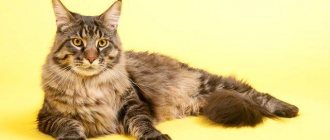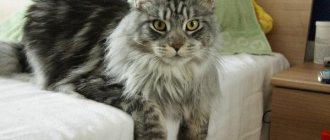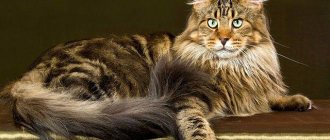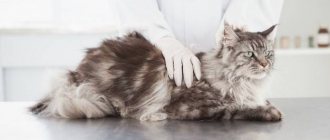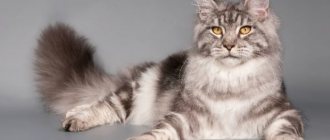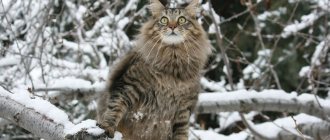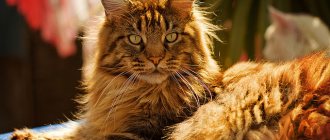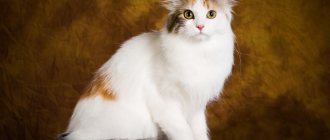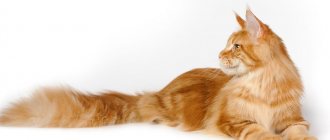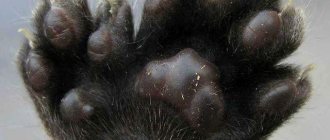Versions of the origin stories of Maine Coons are no less amazing than these cats themselves. Their large size, tufted ears and other breed characteristics have given rise to many myths and legends about where they came from. Among the hypotheses are even such implausible ones as origin from raccoons or lynxes. And, although most of them are fantastic conjectures, each such hypothesis is original and interesting in its own way.
Origin legends
Maine Coons are classified as aboriginal breeds. These cats were not specially bred, but appeared as a result of natural mixing of other breeds. This process occurs under the influence of natural selection, when the strongest individuals survive and produce offspring. They appeared in America, in Maine, where they lived for a long time in the vicinity of local farmers.
Maine Coons helped people by destroying rodents in barns, and for this, local residents highly valued them. As for the exterior, Maine farmers were not interested in it. For them, only the working qualities of these cats were important. But where did Maine Coons come from in America? Or maybe they originally lived there and are natives of these places?
Homeland Atlantis
There is a fantastic hypothesis that the ancestors of the Maine Coons once lived in the north of this sunken continent. When Atlantis split, the miraculously surviving large cats, similar to a lynx, were divided into three populations, which gave rise to new, now well-known breeds:
- Cats that settled in Russia eventually began to be called Siberian.
- The Scandinavian population gave rise to the Norwegian Forest breed.
- The same cats that settled in the mountainous regions of North America were allegedly the ancestors of the Maine Coons.
Sea route
This hypothesis is related to the version that it was not Columbus who was the first European to see the shores of America, but the Vikings. These brave sailors allegedly brought large and fluffy cats to the New World, which they kept on ships to fight rodents. Other researchers believe that the ancestors of the Maine Coon came to America on the ships of the Phoenicians, who were experienced sailors and were not afraid to embark on long journeys. Their ships could also carry large fluffy cats, whose main purpose was to exterminate rats and mice.
If the likelihood of contacts between the inhabitants of Ancient America and the inhabitants of Eurasia is proven by scientists, this hypothesis may not be so implausible.
For now, this version is nothing more than an unconfirmed scientific speculation.
Relationship with raccoon and lynx
The external similarity of Maine Coons with a lynx and a raccoon gave rise to the legend that these cats were born as a result of interspecific crossing.
And they are the fruit of love between the common domestic purr and the North American lynx or even a raccoon.
The first of them, as the creators of these speculations believed, is evidenced by the tufts on the ears of representatives of this breed.
And in favor of the second - a luxurious fluffy tail and a color similar to a raccoon. However, none of the scientists have ever even considered these two versions seriously, since the species differences in these animals are too large and interspecific crossing between them is simply impossible.
Maria - Antoinette
After a revolution occurred in France in 1789 and the royal power was overthrown, Louis XVIII, along with his entire family, wanted to flee the country. His wife, Queen Mary Antunette, who was a great lover of fluffy cats, ordered six of her favorites, presumably of the Angora breed, to be loaded onto the ship.
The escape was unsuccessful: the former king and queen were detained on the way to the port where the ship was waiting for them, and sent first to prison, and later to the guillotine. Samuel Cloa, the captain of the sailing ship on which the royal family was going to go to the New World, was forced to flee persecution to America. Marie-Antoinette's cats, which remained on the ship, ended up in Maine, where, crossing with local purrs, they became the ancestors of semi-long-haired cats with tufts on their ears.
Captain Kuhn
According to this hypothesis, large and fluffy cats were brought to America by an English captain nicknamed, or perhaps named Coon.
This man was supposedly known to be a cat lover.
There were many of them on his ship and, of course, kittens appeared periodically.
Some of these babies remained in the New World, as the captain often gave them away to local residents in the ports where he stopped. The new owners said that they got the kittens from “Raccoon” - that’s how the captain’s surname is translated.
Perhaps this version gave rise to the hypothesis that Maine Coon cats were bred by crossing an ordinary cat with a raccoon.
Apparently, people simply took the phrase “kittens from Raccoon” too literally and, thus, gave rise to a completely different legend about the origin of Maine Coons.
Young Tom Kun
According to this version, the ship on which Tom Kuhn served as a cabin boy once stopped near the Tarbox farm in Maine. The young man sold several long-haired cats that lived on the ship, or perhaps kittens from them, to the owners of this farm.
These animals became the ancestors of modern Maine Coons. And their owner, the mistress of that very farm, became the first breeder of raccoon cats in the world.
Cons of the breed
Maine Coons generously give positive emotions. Their mischievous nature and funny habits can be the subject of colorful conversations with friends and family. Maine cats are characterized by a special tact, the reason for which is the developed intelligence of the pet. The disadvantages of the breed are minor compared to the advantages, and they are quite easy to adapt to.
Expensive price
Any purebred cat will cost you a fair amount of money. The price of kunyat depends on the demand for them. The price of a kitten from a titled parent will be significantly higher than others. You should not try to save money by purchasing a pet for your home without a document or a mixed breed, as such actions support unscrupulous breeders.
Healthy! If you dream of a pet Maine Coon, but the high price scares you, then pay attention to pet-class coons, not intended for breeding, or teenage kittens who have been stuck in a nursery without an owner. As a rule, such animals have an affordable price.
Often, breeding kittens does not bring much income to the breeder. Many procedures associated with maintaining a nursery require significant investment:
- food costs for stud cats;
- vaccinations;
- paperwork;
- genetic research;
- maintaining a website, photographing cats and other advertising for the cattery.
Paperwork for a cat is not an empty bureaucratic formality. The felinological community represents the interests of buyers and also monitors compliance with the rules ensuring the maintenance of the health of cats and the purity of the breed. Ignoring the rules when breeding animals leads to the appearance of half-breeds and increases the number of outbred cats.
When buying a purebred kitten, you need to take into account the cost of its further maintenance. The wide range of prices is explained by the different quality of kittens, which can be sold to nurseries as a producer or as a pet. When purchasing, it is better to focus on average prices.
Wool is everywhere
Maine Coons have medium-length fur, which often becomes a problem. This kind of wool can be found everywhere in the house, even in pots of soup. Brushing twice a week will help significantly reduce the size of the disaster. A brush purchased from a nearby pet store is perfect for this purpose, but don’t forget about the latest technology. Engineers have provided cat owners with a useful device - a furminator, the use of which will help significantly reduce the size of the disaster.
Up to 3 years old your Maine Coon is a kitten
Representatives of the Maine breed are very smart and intelligent. At the same time, the kitten’s mind develops up to 3 years and the animal becomes a full adult about two years after puberty. Considering the weight is under 10 kg and great activity, you should exercise maximum caution when leaving a large kitten alone at home. In another case, returning home, you can find great destruction.
Aggressive leader and keen hunter
Maine Coons are confident leaders. If you have other cats or dogs living at home, then the Maine cat will diligently regain its position as leader, using force. Since its size significantly exceeds that of an average cat of another breed, fights and collisions are possible.
When going out of town with your coon, don’t forget to take a harness that will limit your pet’s freedom of movement. The secret passion of any Coon is bird hunting. Awakened hunting instincts can lead to the destruction of nearby bird nests and complaints from neighboring summer residents about missing chickens.
The need for increased nutrition
Due to their size, Maine Coons have an excellent appetite. When purchasing a pet, do not forget to take care of proper nutrition. Maine Coon food should be rich in proteins and minerals to keep the cat's skeletal and muscular systems healthy.
Eating and toilet problems are closely related. A concomitant disadvantage of the breed is its abundant excrement, which also has a rather pungent odor. A properly selected tray, high-quality filler and regular cleaning will help solve the problem.
If you love big cats, then the disadvantages of the breed will seem insignificant to you. Every year the number of lovers of large cats with a delightful fluffy raccoon tail in Russia is increasing.
Appearance in America
According to one version, Maine Coons were not brought to the New World, but always lived there, leading a semi-wild lifestyle.
Currently, these cats are considered one of the native, and not artificially bred, breeds.
For a long time they were left to their own devices.
The people next to whom the ancestors of the Maine Coon lived did not purposefully breed them and cared least about their appearance.
The first officially recognized representative of the breed is considered to be a cat named Captain Jenks from the naval cavalry. He was presented to the public at a cat show in 1861, and the audience liked him so much that he became very popular, as did the new breed itself. In 1878, 10 Maine Coons were exhibited at an exhibition in Boston, which was even written about in the newspapers, where these cats were called “gentle giants.”
In the 19th century, the popularity of Maine Coons did not last long, since after 30 - 40 years Persian cats came into fashion.
Manx raccoon cats again became the pets of farmers, fortunately their hunting skills by this time continued to be excellent. After that, until the adoption of the first standard in 1967, Maine Coons continued to destroy rodents on American farms and ranches. In the 1980s, a new wave of popularity began, not only in the USA, but throughout the world. In America, Maine Coons are currently the third most popular breed and they are clearly not going to give up their position.
General characteristics and description of the American Maine Coon
Maine Coon - colors
American Maine Coon breed standard:
- Weight. This animal has considerable weight, varying between 5-8 kg. A castrated cat can weigh up to 15 kg. The weight of females is 3.5-9.4 kg.
- Body, bones, muscles. The breed is characterized by a rectangular, long and large body. All parts of the body are proportional. There is a wide chest and a flat back. It has strong bones and powerful muscles. Cats can be smaller than cats.
- Head and muzzle. The head is usually elongated, and the muzzle has pronounced cheekbones. The chin is massive and rectangular in shape. Cats have a wider muzzle.
- Ears. They are large, with pointed tips. The shape of the ears is a regular triangle. The fur growing in the ears extends beyond the outer edges of the ears. The distance between the ears does not exceed the width of the ear.
- Eyes. Large and round eyes, widely spaced. They can be any color.
- Front and hind limbs. Their length is proportional. They are straight when viewed from the back. The paws have a rounded shape. The front ones have 5 fingers, and the back ones have 4.
- Tail. Wide and long tail that tapers towards the end. It is covered with smooth flowing fur.
- Wool. It is quite thick and fluffy. There is a noticeable mane on the neck, and the “pants” have abundant undercoat. Wool has water-repellent properties.
Maine Coon playing
The natural color of Maine Coons is called tabby. It forms a line in the shape of the letter “M” on the pet’s forehead. Similar lines are visible above and below the eyes. The coloring of this color can be classic with wavy stripes, spotted with transitions into stripes, brindle with parallel stripes, or ticked, where the villi are colored in zones in different colors and shades. Photos show various options.
Important! The monochromatic color is the result of long work by breeders. A red Maine Coon without a pattern is considered rare.
In Europe
The first country in the Old World where these cats were brought was France.
It was there that a cat named Charlie was imported from the USA in 1981, becoming the ancestor of the French population of modern Maine Coons.
These cats arrived in England a little later. The first of them were brought to Britain in the mid-1980s. In February 1988, Maine Coons were officially recognized by the GCCF, the largest national association of cat fanciers in England. The popularity of Manx raccoon cats in this country is now so great that they occupy second place in the ranking.
The popularity of Maine Coons in Britain is evidenced by the fact that in 1993 a souvenir coin with the image of this cat was issued on the Isle of Man.
A little later, the breed began to spread throughout Europe and became more and more popular. To date, several hundred nurseries engaged in breeding Maine Coons have been registered in European countries.
Differences
Fans of the American Maine Coon type make every effort to preserve the natural qualities of the breed, while adherents of the “Europeans” strive to change the features of the traditional appearance of these cats and finally consolidate these changes.
The main differences between European-type cats and Aboriginal cats:
- longer body;
- elongated, almost triangular muzzle;
- oval, set far apart eyes;
- large, high-set ears, decorated with lush tassels;
- less voluminous coat, lack of a thick mane and lush “pants” on the paws;
- The color is most often a solid smoky color rather than a patterned tabby or agouti.
One look at the representatives of the European type makes it clear that these cats are decorative pets, reminiscent of a lynx, and not hunters - rat catchers, like the American Maine Coons.
Russia
The first two cats of this breed were brought to Russia from Denmark in 1992.
These were animals from Narnia's nursery.
In those years, Maine Coons were very rare in the country and it was rare to meet them even at large Russian exhibitions.
However, this breed quickly found its admirers, and many professional breeders began to breed Maine Coons. In their breeding work, they used and continue to use now not only Danish bloodlines, but also animals exported from the USA, Finland, Holland, Germany, Austria, Poland, Britain and South Africa.
Thanks to correctly selected blood combinations, Russian breeders have managed to ensure that domestically bred cats are successfully exhibited at major international exhibitions and are serious competitors to Maine Coons from foreign catteries.
